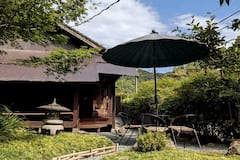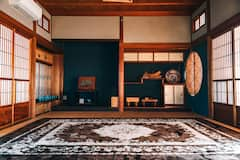Japan is an Asian giant that is also a well-established tourist destination. Millions of tourists throng to its shores to experience the sights and sounds that are very unique to Japan. Famous for its technological advancements, cultural ideologies, arts and crafts, food traditions, nature’s bounty and more, the country seems to be truly blessed by the gods! Its temples and shrines are just as popular as its technology, culture, food and natural beauty. Religion is an important cultural aspect of the Japanese people and a number of ancient Buddhist temples and Shinto shrines are scattered across the country. From Kyoto through Shimane to Yamaguchi, visitors will be enchanted by the amazing religious places in Japan. To know more, take a look at our list of famous temples and shrines in Japan.
1. Kamakura Hasedera Temple

Home to one of the largest wooden statues in Japan, standing tall at 9.18 meters (30.11 feet), is Kamakura Hasedera Temple in Kanagawa prefecture. The 11-headed gilded statue of Kannon, the goddess of mercy, is a must-see at this temple. Additional statues and treasures of the temple can be viewed in the museum attached to the temple. Visitors should also check out the amazing views of Kamakura from the observation platform on the upper grounds of the temple. Picturesque gardens and ponds are perfect for a relaxing stroll.
Kamakura Hasedera Temple
Address: 3 Chome-11-2 Hase, Kamakura, Kanagawa 248-0016, Japan
Website: Kamakura Hasedera Temple
Opening hours: 8am - 5pm (daily)
Price: 3.64 USD
2. Sensoji Temple

Located in Tokyo and constructed on 645, Sensoji Temple is the oldest and one of the most popular temples in Japan; it attracts millions of visitors each year. This Buddhist temple is dedicated to Kannon, the goddess of mercy and is also known as Asakusa Kannon Temple. To get to the gate of the temple, you have to go through the famous Nakamise shopping street that is lined with street food stalls and vendors selling cakes, souvenirs, traditional toys, etc. Inside the temple grounds, check out the Asakusa shrine, various halls, shrines and a five-storied pagoda.
Sensoji Temple
Address: 2 Chome-3-1 Asakusa, Taito City, Tokyo 111-0032, Japan
Website: Sensoji Temple
Opening hours: 6am - 5pm (daily)
Price: Free
3. Horyuji Temple

A world heritage site, Horyuji Temple, is said to house the world’s oldest surviving wooden structures. The main hall of the temple also has a few of the oldest statues of the Buddha in Japan. The temple also has thousands of the most precious and oldest cultural artefacts and artworks of the country that can be seen in the Gallery of Temple Treasures. Visitors should also see the octagonal-shaped Hall of Visions. various other halls, a five-storey pagoda and statues located on the temple grounds.
Horyuji Temple
Address: 1-1-1 Horyuji Sannai, Ikaruga, Ikoma District, Nara 636-0115, Japan
Website: Horyuji Temple
Opening hours: 8am - 5:30pm (daily)
Price: 14 USD
You might be interested in these Airbnbs!
4. Kiyomizu Temple

Also known as ‘Kiyomizu-dera’, Kiyomizu Temple is one of Kyoto’s most well-known Buddhist temples and a UNESCO World Heritage site. Its wooden Kiyomizu Stage stage that juts out of the main hall is perhaps its best-known features and affords scenic views of Kyoto and the wooded areas below, especially in the spring and autumn seasons. Besides its fascinating architecture, the temple is also renowned for its eleven faced and thousand-armed statue of Kannon, goddess of mercy. Visitors must also drink the pure waters of the Otowa Waterfall and visit the various other halls of the temple.
Kiyomizu Temple
Address: 294 Kiyomizu, Higashiyama Ward, Kyoto, 605-0862, Japan
Website: Kiyomizu Temple
Opening hours: 6am - 6pm (daily)
Price: 7 USD
5. Kotoku-in Temple

The Great Buddha statue made of copper, standing tall at 11.4 meters (37.4 feet) and commonly known as Kamakura Daibutsu sits in the open air of the Kotoku-in Temple of Kamakura city. It is considered to be one of the largest Buddha statues in Japan and is the principal worship image at the temple. Other notable features of the temple are stone monuments scattered across the temple grounds, commemorative trees, etc.
Kotokuin Temple
Address: 4 Chome-2-28 Hase, Kamakura, Kanagawa 248-0016, Japan
Website: Kotoku-in Temple
Opening hours: 8am - 5pm (daily)
Price: 3 USD
6. Toshogu Temple

Also referred to as the Nikko Tosho-gu shrine, Toshogu Temple is known for its exquisitely carved and vibrantly coloured buildings. Set amidst a lush forest area, the temple complex has both Buddhist and Shinto elements in its architecture. Other highlights of the temple complex are a five-storey pagoda, elaborately carved storehouses and Yomeimon Gate, carving of Nemurineko (sleeping cat), main shrine, Kairo (Corridor), etc. Visitors can wander around the temple grounds and admire the beautiful artistry of the carvers, painters, craftsmen, woodworkers and other skilled artisans from ancient Japan.
Toshogu Temple
Address: 2301 Sannai, Nikko, Tochigi 321-1431, Japan
Website: Toshogu Temple
Opening hours: 8am - 4pm (daily)
Price: 12 USD
7. Nezu Shrine

Located in Tokyo, the Nezu Shrine is one of the city’s oldest shrines and an important place of worship for locals. It is best known for its Bunkyo Azalea Festival held in April each year when the thousands of azalea trees present in the garden of the shrine are in full bloom. The many vermillion-hued torii gates (traditional Japanese gate) line the pathways leading to the main shrine and several other shrines. A pond, gates and halls are other points of interest here. Visitors can pay a small additional fee to visit the azalea gardens and take in the breathtaking beauty.
Nezu Shrine
Address: 1 Chome-28-9 Nezu, Bunkyo City, Tokyo 113-0031, Japan
Website: Nezu Shrine
Opening hours: 6am - 4:30pm (daily)
Price: Free
8. Shitennoji Temple

Founded in 595, the Shitennoji Temple is one of the oldest in the country. Highlights of the temple are the majestic five-storey pagoda, treasure house and a beautifully landscaped traditional Japanese garden. Various lecture halls, shrines, gates and smaller structures are present in the temple complex. Pay your visit to Kannan, the goddess of mercy, and Prince Shotoku, an important figure in Japan’s Buddhist history, who are enshrined in the main hall of the temple complex.
Shitennoji Temple
Address: 1-11-18 Shitennoji, Tennoji Ward, Osaka, 543-0051, Japan
Opening hours: 8:30am - 4pm (daily)
Price: 3 USD
9. Yushima Seido Temple
Another relatively unknown but important temple in Tokyo is the Yushima Seido Temple. Bringing a Chinese influence on Japanese culture and thinking is this Confucian temple. The gently dilapidated buildings of the temple are surrounded in lush greenery and a large bronze statue of Confucius is also present here. The temple has a Chinese architecture and visitors can take a leisurely stroll through the grounds. Check out the various gates, impressive buildings, majestic trees, statues of animals on the roofs, etc., at this temple.
Yushima Seido Temple
Address: 1-4-25 Yushima, Bunkyo City, Tokyo 113-0034, Japan
Opening hours: 9:30am - 5pm (daily)
Price: Free
10. Yasukuni Shrine

More than 150 years old, Yasukuni Shrine is a memorial to those who laid down their lives for the country. Also known as Yasukuni Jinja, the temple honours the spirits of the people who died in Japan’s various wars like World War I and II, the Sino-Japanese and Russo-Japanese wars, Boshin War, the Manchurian Incident, the Seinan War and the China Incident. Various festivals and rituals honouring the dead are held on the temple grounds each year. Visitors can stroll through the peaceful grounds observing the torii gates, worship halls, gates, garden, cheery trees and visiting the Yushukan museum.
Yasukuni Shrine
Address: 3 Chome-1-1 Kudankita, Chiyoda City, Tokyo 102-8246, Japan
Website: Yasukuni Shrine
Opening hours: 6am - 5pm (daily)
Price: Free
11. Zojoji Temple

Zojoji Temple is a temple belonging to the Jodo Shu sect of Buddhism and is located right next to Tokyo’s famous landmark, Tokyo Tower. One of the most impressive structures of the temple is the majestic two-storeyed, vermilion-lacquered Sangedatsumon Gate. Visitors should also see the Daibonsho (Big Bell), storehouses of text and scripts, the coffered ceiling of the Koshoden lecture hall and the mausoleum of Tokugawa Shoguns. The highlight of the temple is the Amida Buddha image housed in the Buddhist architectural-style main hall of the temple.
Zojoji Temple
Address: 4 Chome-7-35 Shibakoen, Minato City, Tokyo 105-0011, Japan
Website: Zojoji Temple
Opening hours: 9am - 5pm (daily)
Price: Free
12. Kanda Shrine

Home to one of Japan’s three biggest festivals, the Kanda Shrine is an important place of worship in the city of Tokyo. People flock to this temple to pray for good luck, marriage and prosperity that is signified by the enshrinement of the temple’s three prominent deities Ebisu, Daikokuten and Taira Masakado. The temple’s famous festival, Kanda Matsuri or Kanda Festival, is enjoyed by millions and includes processions and parades through Tokyo.
Kanda Shrine
Address: 2 Chome-16-2 Sotokanda, Chiyoda City, Tokyo 101-0021, Japan
Website: Kanda Shrine
Opening hours: 24 hours (daily)
Price: Free
13. Todaiji Temple

Located in Nara, Todaiji Temple is one of the city’s most famous landmarks. The Daibutsu-den (Big Buddha Hall) of the temple houses the massive seated bronze Buddha statue, one of Japan’s largest, and is surrounded by smaller Buddhist statues. The other prominent structure here is the massive Nandaimon Gate, bell tower, lecture and worship halls and the adjacent Todaiji Museum. Deer from the adjacent Nara Park also wander onto the temple grounds and are often fed special crackers by visitors.
Todaiji Temple
Address: 406-1 Zoshicho, Nara, 630-8211, Japan
Website: Todaiji Temple
Opening hours: 9:30am - 5pm (daily)
Price: 6 USD onwards
14. Kotohiragu Shrine

Officially known as Toranomon Kotohiragu, the Kotohiragu Shrine is a Shinto shrine located in Japan’s busy capital city of Tokyo. Nestled amidst tall and modern skyscrapers of Tokyo, this small and ancient shrine provides a peaceful respite from the hubbub of the city. Visitors can admire the traditional architecture, beautiful carvings and animal sculptures and spiritual fervour of the devotees at this 400-year-old shrine. Ancient folk dance performances held on the temple premises also attracts many visitors to the shrine.
Kotohiragu Shrine
Address: 1 Chome-2-7 Toranomon, Minato City, Tokyo 105-0001, Japan
Website: Kotohiragu Shrine
Opening hours: Mon - Fri: 9am - 5:30pm; Sat - Sun: 9am - 4pm
Price: Free
15. Meiji Jingu

Meiji Jingu is a Shinto shrine dedicated to the deified spirits of Emperor Meiji and his wife, Empress Shōken, located in Tokyo and covers an area of 700,000 square metres (7,534,737 square feet). There are about 170,000 trees in the forested area surrounding the shrine, which provides a peaceful respite from the fast pace of Tokyo city outside. Visitors can offer their prayers at the main shrine, buy temple amulets and charms or take a stroll through the many forest pathways. The attached Meiji Jingu Museum can also be visited.
Meiji Jingu
Address: 1-1 Yoyogikamizonocho, Shibuya City, Tokyo 151-8557, Japan
Website: Meiji Jingu
Opening hours: 6:40am - 4pm (daily)
Price: free
16. Nogi Shrine
Experience peace and tranquillity in the busy metropolis of Tokyo at the Nogi Shrine. Also known as the Nogi-Jinjya shrine, this shrine is dedicated to a Meiji era educator and army general, Nogi Maresuke. Visitors can roam the grounds of the shrine any time of the year but the general’s house located adjacent to the shrine is open for viewing only thrice a year. The shrine grounds offer views of the beautiful traditional architecture, vermillion torii gates and lush foliage. A flea market held here every fourth Sunday of the month is also a must-visit for all visitors.
Nogi Shrine
Address: 8 Chome-11-27 Akasaka, Minato City, Tokyo 107-0052, Japan
Website: Nogi Shrine
Opening hours: 6am - 6pm (daily)
Price: Free
17. Kinkaku-ji
Kinkaku-ji is possibly one of the most well-recognised temples of Kyoto. It is a UNESCO World Heritage Site and its Golden Pavillion is visited by millions of tourists each year thanks to the gilded exterior of its main Zen temple. The beautiful temple grounds highlight the Buddha’s teachings and propagate Zen culture. The picturesque Rokuon-Ji garden, the main Zen temple overlooking a beautiful pond, Zen architecture style buildings, a bell and various other natural and man-made features can be seen here.
Kinkaku-ji
Address: 1 Kinkakujicho, Kita Ward, Kyoto, 603-8361, Japan
Website: Kinkaku-ji
Opening hours: 9am - 5pm (daily)
Price: 4 USD
18. Ise Jingu Shrine

Pay your respects to the guardian of Japan, Amaterasu-Omikami, a Shinto deity, who was enshrined in the Ise Jingu Shrine about 2000 years ago. Kotaijingu (Naiku) is the most venerable sanctuary in the country and one of the two shrines that make up the Ise Jingu Shrine. The Geku shrine is dedicated to Toyo'uke-no-Omikami and is highly venerated too. Visitors can offer their prayers, admire the beautiful ancient architecture, observe the delicate carvings and details and visit structures like the Ujibashi Bridge, torii gates, ancient granary, etc.
Ise Jingu Shrine
Address: 1 Ujitachicho, Ise, Mie 516-0023, Japan
Website: Ise Jingu Shrine
Opening hours: 5am - 6pm (daily)
Price: Free
19. Itsukushima Shrine

A UNESCO World Heritage Site, Itsukushima Shrine is also well-known as one of the three most scenic places in Japan. The vermillion ‘floating’ Otorii gate located out in the sea in front of the shrine is one of the most iconic spots of Japan and visitors can walk out to it during the low tide. The shrine is also built on the water and consists of a series of buildings connected by pathways over the water. Besides the main hall, there are several other prayer and lecture halls, a noh theatre (classical Japanese dance-drama performance) stage, corridors, boardwalks, etc. The surrounding forests lend another level of beauty to the Itsukushima Shrine.
Itsukushima Shrine
Address: Dummy address
Website: Itsukushima Shrine
Opening hours: 6:30am - 5pm (daily)
Price: 3 USD onwards
20. Isasumi Shrine

Located in the Fukushima prefecture of Japan is the Isasumi Shrine. This Shinto shrine is one of the larger shrines in the area and hosts the annual popular rice planting ritual. The traditional architecture of the shrine, torii gate, statues, sculptures, beautiful garden, carp pond, etc. are salient features of the shrine. Popular times to visit the shrine are during the rice planting festival, cherry blossom season and Iris Festival of June-July when the 150 species of irises in the shrine garden are in full bloom. Visitors can also enjoy traditional performances, food stalls and booths with traditional craft demonstrations during the festival. The ruins behind the main shrine are also worth checking out here.
Isasumi Shrine
Address: 4377 Miyabayashi, Aizumisato, Onuma District, Fukushima 969-6263, Japan
Website: Isasumi Shrine
Price: Free
21. Tsurugaoka Hachimangu

Located in the centre of the coastal city of Kamakura is its most important Shinto shrine, Tsurugaoka Hachimangu, dedicated to Hachiman, the protector of warriors. Its main shrine is a typical example of Edo-period shrine architecture and can be reached by a long path lined with torii gates. There are two large ponds, a peony garden, various smaller shrines, worship halls, a dance and performance stage, a museum housing several shrine-owned treasures and artefacts. Several unique events and festivals are held at this shrine throughout the year.
Tsurugaoka Hachimangu
Address: 2 Chome-1-31 Yukinoshita, Kamakura, Kanagawa 248-8588, Japan
Website: Tsurugaoka Hachimangu
Opening hours: 6am - 8:30pm (daily)
Price: Free
22. Kumano Nachi Taisha

A Shinto shrine situated at the halfway point on the Nachi mountain, Kumano Nachi Taisha is part of the religious sites and pilgrimage region of Kumano Sanzan. It is also well-known as the site of the tallest waterfall in Japan which is 133 meters (436 feet) high. the surrounding evergreen primaeval forest lends the shrine a mysterious and majestic allure. An imposing cobblestone staircase, Daimon-zaka, with 267 stairs and lined with ancient trees leads to the shrine. Visitors can also enjoy the fire festival of Nachi-no-Hi Matsuri held at the shrine each year.
Kumano Nachi Taisha
Address: 1 Nachisan, Nachikatsuura, Higashimuro District, Wakayama 649-5301, Japan
Website: Kumano Nachi Taisha
Opening hours: 9am - 6pm (daily)
Price: Free
23. Fushimi Inari Shrine

Well-known across Japan and the world by the thousands of vermillion torii gates along mountain paths leading to it, Fushimi Inari Shrine is one of Kyoto’s most famous Shinto shrines. There are about 10,000 torii gates of all sizes at this shrine dedicated to the god of rice, Inari. Visitors can experience walking through the torii gates, visit the five shrines located here, admire the fox statues, attend festivals or witness the rituals taking place at the shrine. Picturesque views of Kyoto can also be enjoyed from the Yotsutsuji intersection located on the shrine grounds.
Fushimi Inari Shrine
Address: 68 Fukakusa Yabunouchicho, Fushimi Ward, Kyoto, 612-0882, Japan
Website: Fushimi Inari Shrine
Opening hours: 24 hours (daily)
Price: Free
24. Kotohira-gu Shrine

Popularly known as Konpira-san, Kotohiragu Shrine is a shrine located on the slope of Mount Zozu in Kotohiro, Kagawa. Visitors have to climb up a total of 1368 steps to the shrine that has elements of both Shinto and Buddhist architecture. In the main shrine of the temple, you can offer prayers to the gods of seafaring, livestock, agriculture and medicine. Beautiful paintings, articles and artefacts can be seen in the various halls and smaller shrines here. Traditional dances in costume can be seen on festival days at the temple. Shopping for souvenirs and dining at udon restaurants right outside the temple can be enjoyed by visitors.
Kotohira-gu Shrine
Address: 892-1, Kotohira, Nakatado District, Kagawa 766-8501, Japan
Website: Kotohira-gu Shrine
Opening hours: 24 hours (daily)
Price: Free
25. Motonosumi-Inari Shrine

Set against the azure backdrop of the Sea of Japan is the Motonosumi-Inari Shrine in Nagato, Yamaguchi. The path leading from the bluff to the shrine consists of a tunnel of 123 torii gates. The vermillion-hued torii gates create a brilliant contrast against the bright blue of the sea making for fabulous photography shots. The shrine is dedicated to the white fox spirit and prayers offered here are said to bring prosperity in travel, pregnancy, business and fishing.
Motonosumi-Inari Shrine
Address: 498 Yuyatsuo, Nagato, Yamaguchi 759-4712, Japan
Opening hours: 5:30am - 5:30pm (daily)
Price: Free
26. Usa Shrine

Popularly known as Usa Jingu or Usa Hachimangū, Usa Shrine is a Shinto shrine that is the principal of all the shrines dedicated to the deity Hachiman, across Japan. Built in the eighth century, the main shrine here has a unique Hachiman-zukuri style architecture and is comprised of an upper and lower shrine complex, a lotus pond with a noh theatre stage in the middle, torii gate, a thatched roof bridge (Kurehashi), other smaller bridges, smaller shrine buildings and a treasure hall. The collection of paintings and musical instruments in the treasure hall is worth checking out too.
Usa Shrine
Address: 2859 Minamiusa, Usa, Oita 872-0102, Japan
Website: Usa Shrine
Opening hours: 5:30am - 9pm (daily)
Price: Free
27. Taikodani Inari Shrine

Counted among the five greatest Inari Shrines in Japan, Taikodani Inari Shrine in Shimane prefecture was constructed in the 1700s. The approach road to the shrine is through a tunnel of over 1000 torii gates and various fox statues are seen across the grounds of the shrine. The shrine also hosts a number of seasonal festivals that attract millions of visitors to its gates each year. Visitors can offer prayers to the enshrined deities who are said to bring good fortune, grant prosperity and ward off evil. You can also walk the grounds of the shrine or simply admire the surrounding beauty.
Taikodani Inari Shrine
Address: 409 Ushiroda, Tsuwano, Kanoashi District, Shimane 699-5605, Japan
Website: Taikodani Inari Shrine
Opening hours: 24 hours (daily)
Price: Free
28. Heian Shrine

In the city of Kyoto, that is home to several dozen ancient temples and shrines, is the relatively new Shinto shrine called Heian Shrine. Built in 1895, this shrine was built to commemorate the 1100th anniversary of the founding of the city and is dedicated to the spirits of the first and last emperors who reigned from here. Visitors can admire the imposing torii gate at the entrance, the bright green and vermillion main shrine building and the beautiful garden complex that can be visited for a nominal price. The gardens here are also one of the best cheery blossom spots in Kyoto.
Heian Shrine
Address: Okazaki Nishitennocho, Sakyo Ward, Kyoto, 606-8341, Japan
Website: Heian Shrine
Opening hours: 6am - 5pm (daily)
Price: Free
29. Atsuta Shrine

The shrine is dedicated to the Shinto deity Amaterasu-Oomikami, the sun goddess. The sacred sword Kusanagi-no-tsurugi, one of the three sacred treasures that symbolise the Imperial throne, is also enshrined here, but never open to public viewing. The ‘Five Great Gods of Atsuta’ are also enshrined here. Many prayer and worship halls, smaller shrines, torii gates, a wooded area and a treasure hall containing a large number of swords, ceremonial masks, sacred garments, ancient documents, etc. are present here too. Visitors can also time their visit to coincide with the myriad festivals celebrated at the shrine.
Atsuta Shrine
Address: 1 Chome-1-1 Jingu, Atsuta Ward, Nagoya, Aichi 456-8585, Japan
Website: Atsuta Shrine
Opening hours: 24 hours (daily)
Price: Free
30. Izumo Taisha Shrine

Since the exact construction dates of Izumo Taisha Shrine located in Shimane prefecture are unknown, it is considered to be the most ancient Shinto shrines in Japan. This important shrine is also known as Izumo Oyashiro is dedicated to Okuninushi no Okami, the Shinto deity of marriage and good relations. Folklore also suggests that all the Shinto gods assemble at this shrine once a year during the Kamiari Festival and visitors try to visit during this time to obtain their blessings. The impressive 24-metres (78 feet) tall main shrine building, various torii gates, a worship hall, smaller shrines, a treasure hall and lodgings for the visiting deities are also worth seeing at Izumo Taisha Shrine.
Izumo Taisha Shrine
Address: 195 Taishacho Kizukihigashi, Izumo, Shimane 699-0701, Japan
Website: Izumo Taisha Shrine
Opening hours: 24 hours (daily)
Price: Free
Spiritual Japan
Buddhism to Shintoism, religion plays an important role in the daily life of the Japanese people. Visits to the religious places of the country should form a part of all visitors’ itineraries. When you go to Japan, do remember to consult our list of famous temples and shrines in Japan.
History
Get Trip101 in your inbox
Unsubscribe in one click. See our Privacy Policy for more information on how we use your data























Create an account to